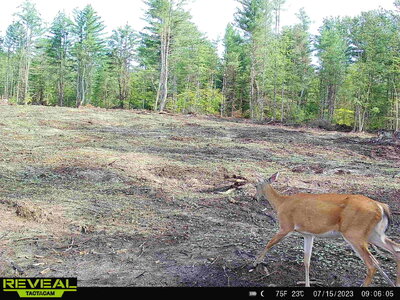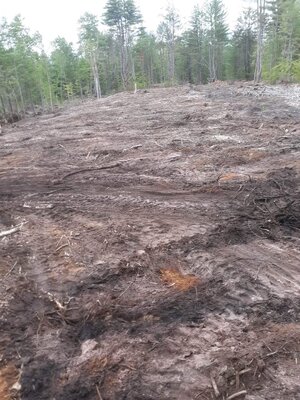Question for some of you experienced folks. I have two plots that were just cleared as part of a logging operation. Both are about 1 acre of useable planting area that I plan to keep expanding. Soil is sandy. One is dry, the other is pretty moist although I think it’ll keep drying up over time now that sun can hit the ground. Soil test showed pH in the upper 4’s and very little organic matter. My plan is to always keep something growing with the ultimate goal of building up the soil. I planted buckwheat a week ago and you can see it’s growing pretty well. I’ve seen a lot of guys talk about broadcasting WR and/or WW into the standing BW for a fall plot then use the cultipacker after seeding. I have the ability to disc/seed/cultipack with my Firminator. It seems like discing the BW in as part of my fall planting would help it decay quicker and build OM faster than leaving it on the surface. Does that sound right or am I doing more harm than good going that route?
View attachment 25712View attachment 25713 I got 1 ton of lime per acre before the BW and will repeat that for the fall planting. Thanks!
Organic matter is built both above ground as plants die and decay, as well as below ground as roots decay. It takes may years to build organic matter and very little time to destroy it. The poorer soil you have (like sandy) the more important it is to not waste the organic matter you have. Any time you till, you introduce Oxygen into the soil. The O2, significantly increases the rate at which the microbes consume OM.
The best thing you can do is to avoid tillage. There are times when light tillage may be necessary. For example if you had heavy clay with low OM, crusting can be common. The clay forms such a hard glazed surface it becomes hard for plants to penetrate and grow. In that case, very light tillage may be beneficial. Top inch or less is more than adequate. The deeper you till, the deeper you introduce O2.
With sandy soil, you especially want to avoid tillage. Sand is infiltrated very easily. Water, lime, and nutrients drain through the soil quickly. Building OM is the best way to slow down this infiltration benefiting plants.
In order to build OM, the first rule is do no tillage unless it is absolutely necessary like in the case above. With pH that low, you will need a lot of lime and with sand, that lime will more through the soil much more quickly than clay or loam. Don't be surprised if you need to add more maintenance lime more frequently than folks on other soil types. Top dress the lime and don't be tempted to till it in.
As for planting, you are off to a good start. Buckwheat needs nothing more than to touch the ground by mowing to begin to break down. There is no need to disc at all. Thatch management is not an issue on a new plot. You want dead plants laying on the soil decomposing, but at some point as soil becomes more fertile, you can get too much and need to consider how to manage it. None of this will be a problem for many years in your plot. Some folks are in a position where there is so much vegetation on the soil, it is difficult to get good seed/soil contact which is a must for germination. Sometimes under these conditions light tillage exposes enough soil (you don't need much). Again, you won't have these issues for many years when your OM levels rise.
The key to building OM is to mix plants that have complementary characteristics with plants that produce Carbon when the dye like grasses (I'm not talking about fescue here) . Cereal grains can provide this. In your case, forget about WW and focus on WR. It will do much better in your soil conditions and fills the same niche for deer. You need add Nitrogen fixing legume to the WR for your fall plant.
Don't fall for the temptation to till and cover seed for moisture. You loose soil moisture when you till. The seeds like WR and Clover will be fine just broadcast and cultipacked. If you are concerned about moisture, (and this is always best), plant with rain in the forecast. That rain will be more than sufficient for germination. Because you didn't till, the soil will hold more moisture for the plants after they germinate.
The great thing about broadcast and cultipack techniques, is that you don't need a real even field. It works fine even on new ground that is uneven.
You seem to be on the right track in general.
Best of luck!

 I got 1 ton of lime per acre before the BW and will repeat that for the fall planting. Thanks!
I got 1 ton of lime per acre before the BW and will repeat that for the fall planting. Thanks!
 I got 1 ton of lime per acre before the BW and will repeat that for the fall planting. Thanks!
I got 1 ton of lime per acre before the BW and will repeat that for the fall planting. Thanks!